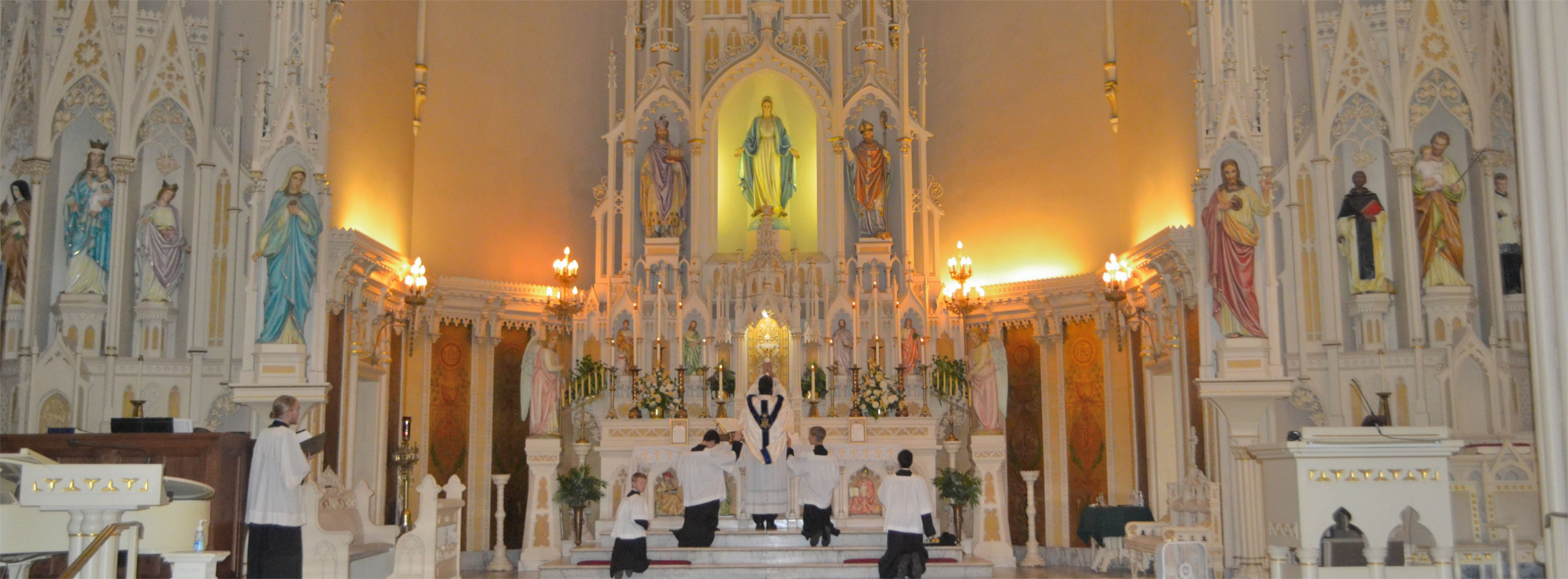The following is a brief overview for those who have never attended a Latin Mass or may be wondering what to expect and how to participate.
Elements of the Extraordinary Form of the Mass, as it’s called today, have been practiced since the earliest centuries of Christianity. For nearly 500 years, including half of the twentieth century, this form of the Mass was uniformly celebrated in all Holy Sees all around the world. It is spoken in the Latin language and celebrated Ad orientum (that is, with the priest leading the people “to the liturgical east” – toward the altar, tabernacle, and crucifix).
Each Holy Sacrifice of the Mass is offered at four ends: Adoration, Thanksgiving, Reparation, and Petition.
There are different ways of celebrating the Mass:
Low Mass (Quiet Mass) in which 2 lighted candles are on the Altar and no prayers are sung or chanted.
High Mass (Sung Mass) in which 6 candles are lit. Much of the Mass is sung including the Gloria, Creed, Sanctus, Gospel, Sanctus, Our Father, and Agnes Dei.
Solemn High Mass, which is a full Ceremonial sung Mass. A Deacon and Subdeacon typically assist the Priest.
While most of the Mass is spoken or sung in Latin, a side by side English translation booklet missal is provided for everyone. Step by step instruction and explanations can be found in the sidebars. The postures of the congregation – when to sit, stand, or kneel, are also printed within. Many people enjoy bringing a personally owned Missal to Mass to further their understanding, devotion, and participation.
Like any Catholic Mass the liturgies are divided into two parts:
The liturgy of the Word, which includes scripture readings from The Holy Bible and a homily for instruction. The readings are repeated and the sermons are spoken in the common vernacular.
The liturgy of the Eucharist, which is the “source and summit” of the Faith for all baptized Christians as the body, blood, soul, and divinity of Jesus Christ is made present as the New Covenant. This is the eternal sacrifice, consummated on the cross, and re-presented in an un-bloody manner as commanded by our Lord.
All are invited to make a Spiritual Communion, however only baptized Catholics in the state of grace may receive Holy Communion. The consecrated host is customarily received in the kneeling position and on the tongue. (The communicant does not say “Amen.”)
It is permissible for those not receiving Holy Communion to kneel at the communion rail with arms crossed across the chest to receive a blessing, although the same blessing is bestowed upon all present near the conclusion of Mass.
The wearing of veils is not a requirement, but rather a matter of devotion.
The following prayers are recited after Low Mass: The Hail Mary, Hail Holy Queen, God Our Refuge and Strength (Psalm 46), and The Prayer to St. Michael.
It is customary to make a final prayer of thanksgiving, typically while kneeling, once the priest has processed out of the sanctuary.
To show our Lord due reverence, as He remains present in the tabernacle and out of respect for those in prayer, please visit with fellow Massgoers in areas outside the sanctuary.
